Reporting the South China Sea Dispute: Lack of context still at issue
By way of background: The Justice Carpio Lecture
Associate Justice Antonio Carpio delivered a lecture on the West Philippine Sea dispute between China and the Philippines at the Ayuntamiento Building in Intramuros, Manila last April 23.
Carpio’s presentation provided the necessary historical and empirical context to shed light on the causes of the dispute. Supported by ancient maps, UNCLOS and international law provisions, examples of previous arbitration cases filed by other countries, and extensive historical and geopolitical studies by third parties, the lecture explained the significant stakes involved and the rationale of the Philippine arbitration case against China. But while Carpio was interviewed after his lecture, the details of the lecture itself were not reported extensively.
And yet, the lecture provided the media the opportunity to enhance the public’s understanding of the dispute and the stakes involved. It could have been used by the media to provide the context to a controversy that is seen by others as a flashpoint for an international conflict that could engage more countries. CMFR has identified this lack of context as one of the weakest points in the coverage of complex issues.
Among others, Carpio proved that:
- China identifies the basis of its claim on parts of the South China Sea as historical, using a 1947 map that presented what China calls a “nine-dashed line” running along arbitrary coordinates in the disputed area.
- The 1982 United Nations Convention on the Law of the Sea (UNCLOS), to which China and the Philippines are both signatories, includes in its provisions the concept of the Exclusive Economic Zone (EEZ), an area 200 nautical miles from a state’s coastline where the exploration, exploitation, and management of natural resources, both living and nonliving, are exclusive to the coastal state.
- The establishment of the EEZ and UNCLOS itself debunks any historical claim to territory by any signatory to the UNCLOS. The nine-dashed line, which was not measured from the baselines along the coast of China, is non-compliant with the basic requirement of the UNCLOS for assigning maritime zones.
- China’s aggressive reclamation in the Spratlys severely damages reefs that took millions of years to form, threatening the breeding grounds of fish and potentially depriving the country of 20% of its annual fish catch.The country will also lose about 80% of its EEZ, including part of the Malampaya gas field.
- French geologist Francois Xavier Bonnet, in a forum held at Ateneo de Manila University last March 27, revealed that his extensive research on the subject had uncovered that the “sovereignty markers” that China put up in the Paracels and the Spratlys were antedated. Carpio also presented a digital copy of the 1734 Murillo map in which the Scarborough Shoal was labeled with the Tagalog word Panacot (threat in English)– 213 years before China drew its nine-dashed line.
Earlier this year, the United States, through the Center for Strategic and International Studies (CSIS) released satellite images showing accelerated progress in China’s construction of artificial islands and structures in the disputed area. China’s continuous occupation has resulted in the exclusion of natives of the area from access to their traditional sources of livelihood. Local fisherfolk and sea vessels have also been reported to have been harassed by Chinese forces who drive them away from waters that are part of the Philippines’ EEZ.
The illegal exploitation of the rich natural resources of the West Philippine Sea poses a threat to the international relations and national security not only of the Philippines but also that of other claimants such as Vietnam, Malaysia, Brunei, Indonesia, and Taiwan. Major stakeholders in the contested region such as the United States and Australia are also affected by the repercussions of the Chinese reclamation.
The Philippines filed an arbitration case before the International Tribunal on the Law of the Sea (ITLOS) in 2013, seeking the jurisdiction of the Permanent Court of Arbitration in The Hague, The Netherlands, over the case. China has refused to participate in the proceedings, insisting on bilateral negotiations to settle the dispute.
The Center for Media Freedom & Responsibility (CMFR) monitored the main news sections of the Philippine Daily Inquirer, The Philippine Star and the Manila Bulletin, and the primetime news programs TV Patrol (ABS-CBN), 24 Oras (GMA-7), and Aksyon (TV5) from April 1 to July 15, 2015, in which period occurred the the release of the aforementioned satellite images, the public lecture of Justice Carpio, and the oral arguments on the Philippine’s arbitration case against China at The Hague.
Frequency and breadth of coverage
During the period monitored, the Star published the most number of news reports on the dispute (208). Of these, 89 appeared on the front page; 19 out of the 89 news stories were published banner stories. The Inquirer published 167 reports, of which 59 appeared on the front page, and 12 of which were banner stories. The Bulletin had 106 stories on the issue; 65 were on the front page, of which 14 were banner stories.
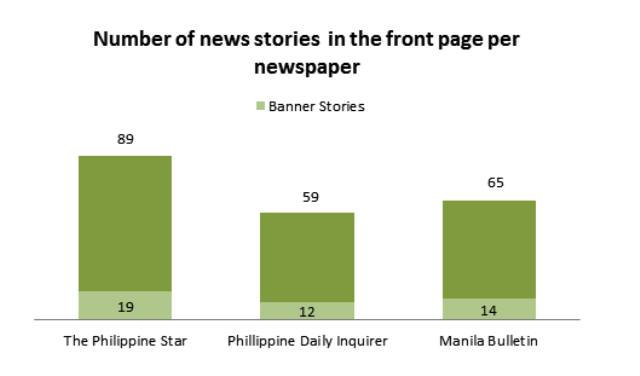
For television, Aksyon aired 43 stories during the period monitored. TV Patrol produced 31 reports, while 24 Oras aired 20 reports.
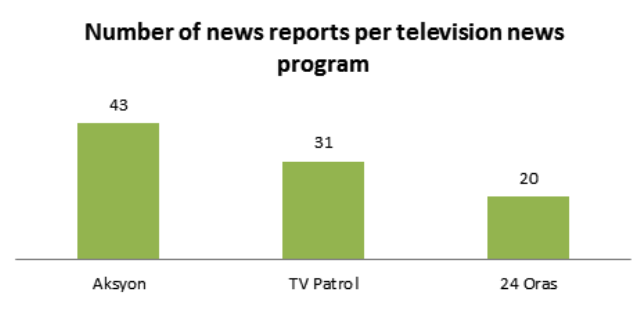
Much of the coverage depended on events such as the ASEAN Summit held in Langkawi, Malaysia last April 26 to 28, the war games or Balikatan operations held last April 20 to 30 as part of the Mutual Defense Treaty between the United States and the Philippines, the Japan-Philippine naval drill conducted on May 12, President Aquino’s state visit to Japan in June 2, the Cooperation Afloat Readiness in Training or CARAT exercises between the US Navy and the Armed Forces of the Philippines, and the “shooing away” of US planes flying over the reclaimed area by Chinese aircraft. Incidents involving the harassment of Filipino fishermen by the Chinese Coast Guard, and the subsequent effect of the Chinese occupation on the livelihood of the locals in the disputed area were also reported.
Many sources, shallow coverage
While there was a multitude of sources in the reports, the coverage used statements of government officials more frequently than others. Below are the top five Philippine sources used by the media in the coverage of the dispute during the period monitored:
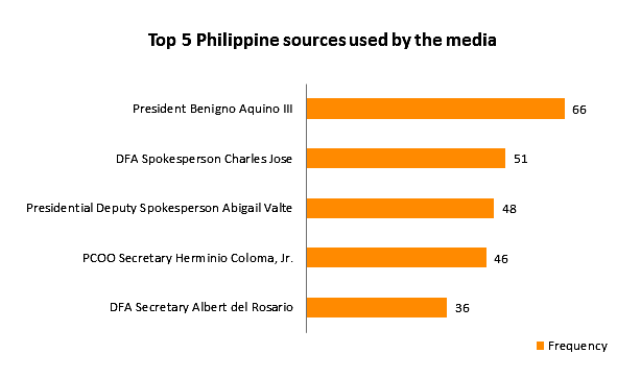
Most of the international sources used in the reports were also from the government. Below are the top five sources from the United States and China.Senators, representatives, as well as fisherfolk and local government officials were also used as sources, but not as extensively as the abovementioned persons. For print, the Inquirer published most of the reports that used locals as sources (PH fishers recount ordeal near shoal; Small PH fishermen losers in sea dispute).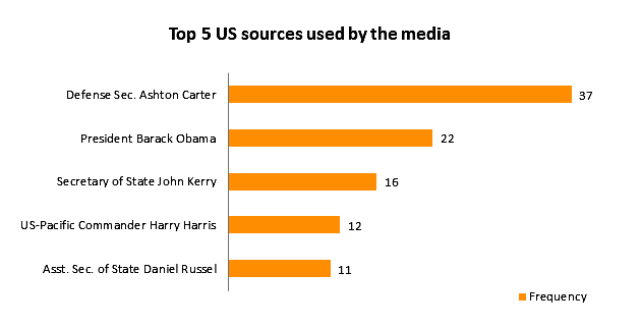
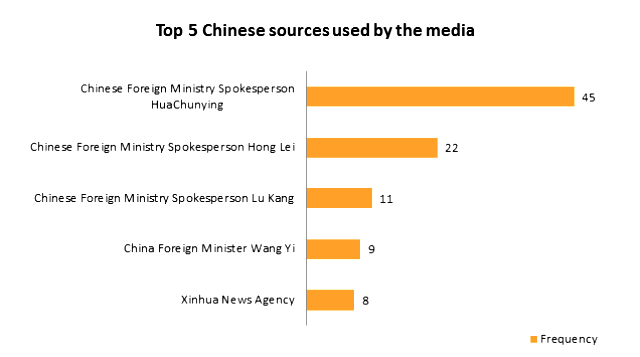
Government sources from other countries such as Vietnam, Taiwan, Indonesia, Malaysia, and Japan were also used in some reports.
Many reports published by the three broadsheets monitored were also outsourced from the news wires such as the Associated Press, Agence France Presse, Reuters, Bloomberg, The Wall Street Journal, and the New York Times News Service.
Since most of the reports depended on high-ranking officials and leaders of concerned countries as sources, a large proportion of the content of the stories was devoted to statements they made in public gatherings or conferences, resulting in a “he said, she said” kind of reporting. This kind of coverage tended to initiate a “word war” favoring one country over another, and is likely to have triggered hostile sentiments from readers to the detriment of reasoned thought.
Some of the newspapers and TV networks did attend the presentations of experts on the subject, but there was no proactive effort to consult them for further information and insights, despite the fact that the country does not lack experts in both government and the academe.
The news reports tended to pit the Philippines and China against each other, while implying US hostility to China and support for the Philippines to the extent of suggesting that armed hostilities could occur. This was evident in the framing of the US’ joint military exercises with the country. The US, being a major global power and an ally of the Philippines, was usually portrayed as a “savior,” since the two countries have an existing mutual defense agreement. (US support boosts PH’s resolve to address sea dispute with China, Manila Bulletin; Obama scores China bullying in S. China Sea, Philippine Daily Inquirer; Goldberg: US committed to Phl security, The Philippine Star)
Some reports noted how the Philippines seemed to have found another ally in Japan which is also locked in a longstanding row with China over disputed islands in the East China Sea. This matter was also highlighted during President Aquino’s state visit to Japan. (PH, Japan hold historic naval drills in flashpoint waters, Manila Bulletin; Phl, Japan to deepen ties amid China sea claims, The Philippine Star; US, Japan expand defense ties amid tensions with China, Philippine Daily Inquirer)
Despite the plethora of stories on the subject, Philippine media were remiss in producing the in-depth and contextualized reports that could have discussed the impact of the Chinese reclamation on global politics and on the Philippines. Conspicuously absent was any emphasis on the Carpio lecture.
The reports were so focused on disagreements between the Philippines, US and China that other stakeholders were almost voiceless in the reports. The media could have asked why other ASEAN countries, who are also claimants to the contested waters, did not file an arbitration case against China. The political and economic partnerships between these countries and China as well as the Philippines’ own could have been examined more closely.
The Philippines and its neighboring countries were reported as claimants to the disputed area, but the media did not discuss what exactly the interests of these nations are. The same was true with non-ASEAN countries such as the United States and Australia. The US has repeatedly declared that it will not side with any country in this dispute, but much of the media continued to suggest that the US might even support the Philippines militarily in case of a direct military conflict . A statement by US Secretary of Defense Ashton Carter on the US global policy of “going wherever international law permits,” for example, was reported as suggesting that the US would indeed do so, and that it was a warning to China.
Terms like the EEZ, UNCLOS, or the nine-dashed line were only mentioned in passing but not lengthily explained. The provisions of the UNCLOS that are essential in explaining the Philippine side of the dispute were rarely mentioned.
Another subject that the media failed to meaningfully report was the arbitration case filed by the Philippines. Explaining the process of filing an arbitration case and the evidence used by the Philippines in support of its position, such as maps and provisions of the UNCLOS, could have greatly helped in making the Filipino public understand the basis of the diplomatic approach that the Philippine government has taken. But the media also missed that opportunity.
Even the coverage of the oral arguments in The Hague did not result in improved reports. The details of the case remained undiscussed as the media focused on repeated statements of members of the Philippine delegation expressing their determination and confidence that the country would get a favorable ruling from the tribunal.
Rare reports on ignored issues
While most of the reports failed to contextualize the dispute and provide the essential information on the possible impact of the reclamations to the Philippines, some news stories did try to present otherwise ignored issues. But these were relatively rare.

Screengrab from RTV-Malacanang YouTube channel
The Philippine Daily Inquirer reported Justice Carpio’s emphasizing the importance of the decision on the arbitration case filed by the Philippines against China. Carpio said that if the tribunal decides it has no jurisdiction over the dispute, the UNCLOS would be futile and all other countries may claim parts of the seas without considering any existing law. (Carpio: PH could win case if UN tribunal affirms its jurisdiction, June 26)
The Manila Bulletin published a report on the economic losses the Philippines will incur annually due to the large-scale reclamations of China. The Bulletin cited a study on coral reef ecosystem damage conducted by National Scientist and University of the Philippines Marine Biology Professor Emeritus Edgardo Gomez. The report also mentioned the illegal poaching of marine resources in the area and the resulting ecological imbalance. (‘Ocean filling’ activities cost US$108.9 M per year – study, April 24)
The Philippine Star reported on the threat to energy security brought about by the activities in the West Philippine Sea. Citing the US Energy Information Administration, the report said that EIA estimates about 11 billion barrels worth of oil and 190 trillion cubic feet of natural gas reserves in the disputed area are at risk of being exploited illegally by China. (Chinese reclamation affecting Philippines’ energy security bid, April 27)
The Star also provided background information on the documents that both the Philippines and China submitted to the Arbitral Tribunal, all leading to the proceedings at The Hague. (It’s David and Goliath at The Hague, July 8)
Of all the newspapers and news programs monitored, only TV Patrol reported the important points raised in Justice Carpio’s lecture last April 23. The report also cited Carpio’s suggestion that the country should ‘beef up’ its own defense capabilities instead of relying on US’ protection. TV Patrol immediately followed up with a story on the Enhanced Cooperation Agreement (EDCA) and 1951 Mutual Defense Treaty between the Philippines and the United States, citing a provision that says the West Philippine Sea is not included in the areas covered by US defense.
Aksyon was also the only one to report about the three-part Philippine-produced documentary that aims to inform the public about the legal, economic and historical angles of the dispute.
The reporting was at best uneven. There was not one paper or program that gave the kind of attention to a subject that has been seen as politically, economically and internationally crucial to the Philippines and its neighboring ASEAN countries. A BBC report on September 2014 indicated the China reclamation as clearly expansionist moves that could cause a major shift in the geopolitical balance in the Pacific. The report said, “What’s going on in the South China Sea is an expression of China’s intent. Beijing’s ambition is to dominate the sea-space within the “first island chain. In the longer term it wants to move further, beyond the Philippines, and southern Japan – to the “second island chain”… to Palau, Guam and the Northern Mariana Islands. This will be a seismic shift in the balance of power in the Western Pacific. For the past 70 years US power has been unassailable in this region.”
These points underline the need for the Philippine media to sharpen its capacities to provide context and to ask the pertinent questions, the answers to which could enhance its audiences’ understanding issues of common interest, which in turn depends on practitioners’ readiness to undertake research. The presentation of Justice Carpio provided the media enough information to take the place of proactive research, but the latter still failed to provide the context Philippine media audiences sorely need.
Leave a Reply